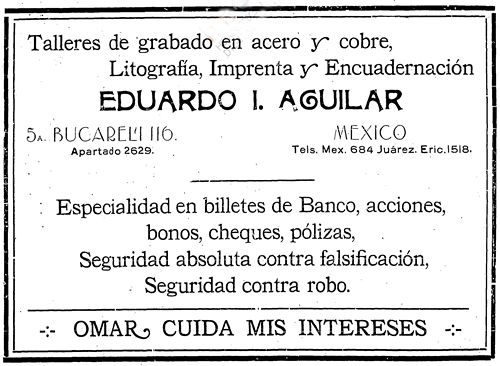Eduardo I. Aguilar
Eduardo I. Aguilar’s normal business, located at calle 5a Bucareli, número 116, was printing books and he also produced two illustrated magazines, El Mundo Ilustrado and La Semana Ilustrada. However, by September 1914 he was advertising a speciality in banknotes, share certificates, bonds, cheques and policies with an absolute security against counterfeitingEl Mundo Ilustrado, 20 September 1914.

He was responsible for three different issues in 1914, a 50c note for the Banco Minero de Chihuahua and $1 notes for the Banco de Morelos and Banco de Zacatecas, none of which reached circulation.
On 28 September 1914 a José Campero took an inventory of Aguilar’s workshop on behalf of the authorities. Having made a detailed inventory of all the stocks of paper, inks, presses, linotype machines and accessories, he opened the door to a darkened cellar and was surprised to find several wooden boxes full of brand new banknotes. There were 1,200,000 $1 Banco de Morelos and nearly 300,000 $1 Banco de Zacatecas, lacking only signatures and the Secretaría de Hacienda validation. The police were informed and took away everything, including the plates used to print the notesEl Liberal, 29 September 1914. By an ironic coincidence, the next day, 29 September 1914, Andrés Padilla, a litographer for Eduardo Aguilar, wrote to President Carranza, complaining that the forced closure of the print shop had thrown all the employees out onto the streets without hope of work. The reason the authorities had given for the closure was the fact that Eduardo Aguilar had printed some banknotes, but Padilla asked that loyal supporters who only wanted stability, peace and work should not be punished as wellCEHM, Fondo XXI, carpeta 16, legajo 1626.
On 16 October the police, summoned by Alvaro Pruneda, hijo who had taken over control of the workshop, returned and on this occasion found $1m in 50c notes of the Banco Minero de Chihuahua, packed into ten boxesNueva Patria, Tomo I, Núm. 23, 18 October 1914: Regidor, 4 November 1914.
Although the Banco de Zacatecas had decided not to issue their $1 notes they wanted to recover them and by 9 December had done so. The printer asked to be paid for the job, despite the fact that it had not been finished, and by February 1915 they had reached an agreement by which the bank paid $734.92 and Eduardo Aguilar delivered a box with the unfinished notes and the corresponding front and back plates. The bank agreed that both the unfinished notes and the plates should be destroyed.
Aguilar continued as a printer after the revolution and by 1928 was the general manager of the Excelsior newspaper.
